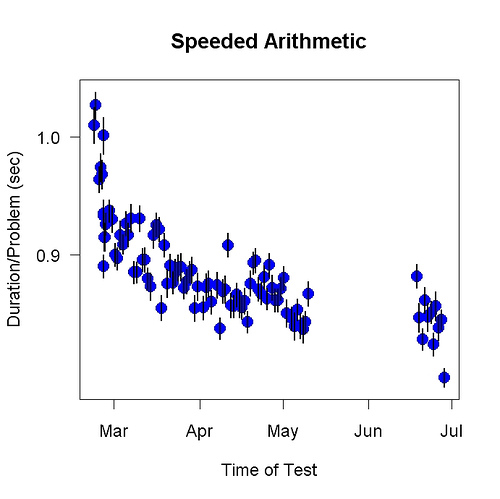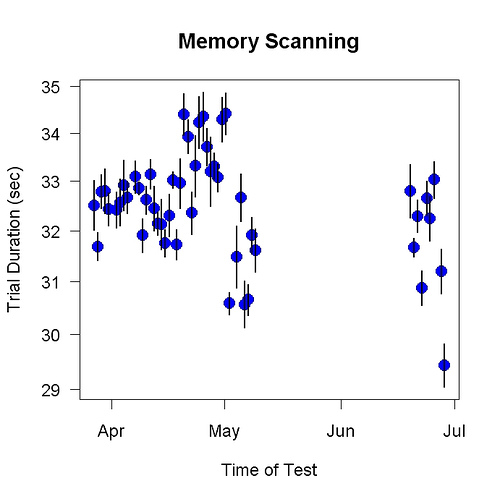The following is from a friend of mine. He is in the middle of a self-experiment to measure the effect of various forms of Coca-Cola (regular, diet, diet w/o caffeine) on his mood.
TODAY’S EVENT
Today ~20 oz of coca cola (w/ caffeine and w/ sugar) dramatically eliminated (in about a minute) a very real, strong feeling of irritability.
BACKGROUND
I am on day 17/30 of the experiment and I am still blinded to the results of the first 16 days. I do know that none of my previous mood experiences in the past 16 days were like the one today.
I had a significant bought of irritability (6/10) today. This irritability has been brewing last 48 hours but was palpable all morning after I woke up this AM. This irritability was the REAL DEAL that I have been seeking the past few weeks – my family was well aware of my irritability yesterday and this AM. Since this irritability was so palpable, I decided to break my experimental protocol and drink a known real coke. Quite remarkably, within a minute or so of consuming the whole coke (~20 oz – large) my irritability was gone (really gone). [He drank the coke in 2 or 3 minutes. The effect lasted about an hour.] Be clear, this was not some psychological maybe I feel this maybe I don’t, this was real psychiatric, can’t miss it, need some drugs, psychotropic bad/irritable feeling.
The past 16 days of this experiment has made me very familiar with hunger, bad moods, hunger irritability, assessing my feelings around hunger, assessing feelings around soda pop, assessing feelings around a good meal. Therefore, today I was well prepared to focus on the minute to minute dynamics around drinking this coke – the coke abruptly ended hours of feeling irritable (no better word to describe the mood than irritable).
RESULTS
-1) Now that I am half way through the experiment, I think I can break the blind by identifying the three different types of coke. I can taste the clean sweetness of real coke immediately, I can feel caffeine in my body from the diet coke in about 5 minutes.
0) I am currently blinded to the results of the experiment I am doing. However, I do have some anecdotal impressions that presumed diet w/o caffeine causes no mood affect, diet w/ caf does affect mood, coke w/ caffeine and w/ sugar does affect mood. My anecdotal impression is that these effects are mild to modest.
1) Today was the first time I felt psychiatric grade irritability confounded by hunger irritability. Today unblinded Coke abruptly eliminated the bad feelings associated with this irritability.
2) I have been rating my mood with full meals 20-40 minutes after my soda pop drink and my impression is that real satiation does have some positive mood effects.
DISCUSSION
The big target is understanding how 20 oz of sugar and caffeine totally eliminates the strong and persistent feeling of psychiatric grade irritability confounded by hunger irritability. Designing an experiment to go for this issue is challenged by the infrequentness of this psychiatric grade irritability.
Coke eliminating irritability appears to produce happiness by eliminating the presence of bad irritability feelings. In this setting, Coke did not produce any positive feelings, Coke simply eliminated some strong bad feelings. Coke is not producing a good mood, it removed a bad one. (There may have been some “psychological” grade good mood, but this was so tentative and hard to assess that I am happy saying Coke produced no positive affect. The removal of the psychiatric irritable mood was clear and absolute).
In contrast to the absence of irritability caused by coke (and no good mood effects), I think the satiation I have experienced these past 16 days from the big healthy meals following my soda pop does has some positive feelings associated with it. Satiation presumably feels good not just because of elimination of hunger, there seems to be some warm glow from eating a large, well-balanced, fatty, carbo, vegetable, sweet meal.
There appear to be different kinds of irritability. More than six hours without food brings on a form of irritability, but this hunger irritability appears to be different from “mood” irritability. Mood irritability lasts for days while hunger irritability lasts for hours. Hunger irritability produced in the setting of no mood irritability is not that profound. Hunger irritability on top of mood irritability appears to be the REAL DEAL of irritability. It is this REAL DEAL of irritability which today (and typically) creates the setting such that a large caffeine/sugar soft drink eliminates the persistent palpable bad feelings associated with REAL DEAL irritability.
I understand why it would be nice if the subject is blinded. However, I am not sure the subject needs to be blinded. I think one still gets meaningful results even if placebo/nocebo effects are folded into the results.
CONCLUSION
A couple of days of irritability compounded by hunger produces a strong form of irritability which was dramatically relieved by a large glass of caffeine/sugar coke today (unblinded N = 1 in experiment). Strategies for further behavioral characterization of this phenomenon are needed. A physiological hypothesis is needed. A future design for FMRI measurements of this quick irritability response to caffeine/sugar will be fun to design.
In the final analysis, I guess it is worth finishing the current experiment – even though I think I can determine the identity of each drink. Good data from an inadequate experimental design will be helpful in creating a better experimental design.
About the author: John Keltner has a Ph.D. in Physics from UC Berkeley and an M.D. from Harvard. He is a research fellow at the University of Oxford. Given these results, I asked John if he was addicted to caffeine. He told me no, going without caffeine did not make him more irritable.





